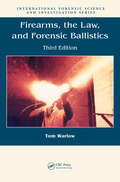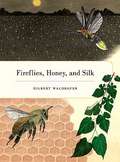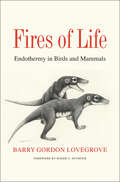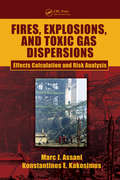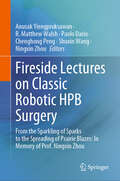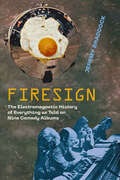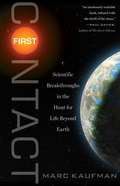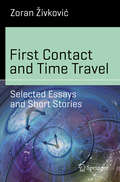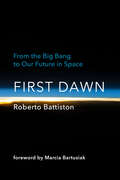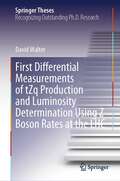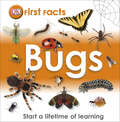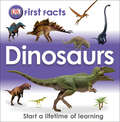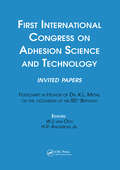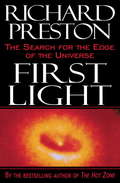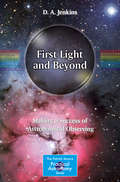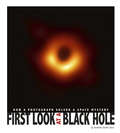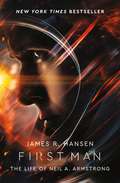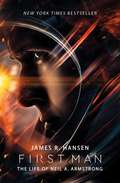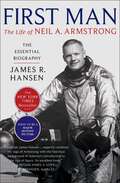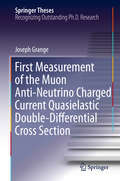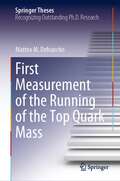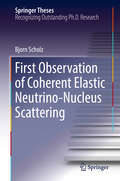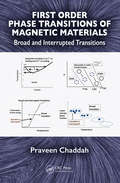- Table View
- List View
Fire: Fundamentals and Control
by Walter M. HaesslerThis book is devoted to the complex nature of fire, the intricasies of the combustion process, the influence of chemical and physical properties of fuels, and the proper means of fire extinguishment. It lists sequentially the various factors in the combustion process.
Firearms, the Law, and Forensic Ballistics
by Tom WarlowWhile gun design has undergone only minimal change over the centuries, investigative tools surrounding firearm use have grown significantly in sophistication. Now in its third edition, Firearms, the Law, and Forensic Ballistics has been updated to reflect recently published research and new technology developed since the last volume. Beginning with
Fireflies, Honey, and Silk
by Gilbert WaldbauerThis enchanting book is a highly entertaining exploration of the myriad ways insects have enriched our lives--culturally, economically, and aesthetically. Writer describes in loving, colorful detail how many of the valuable products insects have given us are made, how they were discovered, and how they have been used through time and across cultures.
Fires of Life: Endothermy in Birds and Mammals
by Barry Gordon LovegroveA groundbreaking argument on how endothermy—arguably the most important innovation in vertebrate evolution—developed in birds and mammals&“Vividly narrated and illustrated. . . . Provocative and fascinating for specialists and lay readers alike.&”—Southeastern Naturalist This pioneering work investigates why endothermy, or &“warm-bloodedness,&” evolved in birds and mammals, despite its enormous energetic costs. Arguing that single-cause hypotheses to explain the origins of endothermy have stalled research since the 1970s, Barry Gordon Lovegrove advances a novel conceptual framework that considers multiple potential causes and integrates data from the southern as well as the northern hemisphere. Drawing on paleontological data; research on extant species in places like the Karoo, Namaqualand, Madagascar, and Borneo; and novel physiological models, Lovegrove builds a compelling new explanation for the evolution of endothermy. Vividly narrated and illustrated, this book stages a groundbreaking argument that should prove provocative and fascinating for specialists and lay readers alike.
Fires, Explosions, and Toxic Gas Dispersions: Effects Calculation and Risk Analysis
by Marc J. Assael Konstantinos E. KakosimosToday's risk analysis is a very challenging field, and a solid understanding of the calculations procedure associated with it is essential for anyone involved. Fires, Explosions, and Toxic Gas Dispersions: Effects Calculation and Risk Analysis provides an overview of the methods used to assess the risk of fires, explosions, and toxic gas dispersion
Fireside Lectures on Classic Robotic HPB Surgery: From the Sparkling of Sparks to the Spreading of Prairie Blazes: In Memory of Prof. Ningxin Zhou
by Paolo Dario Anusak Yiengpruksawan R. Matthew Walsh Chenghong Peng Shuxin Wang Ningxin ZhouThis book presents a collection of case reviews on robotic HPB (Hepato-pancreato-biliary) surgeries contributed by distinguished surgical experts and robotics engineers. Each case is accompanied by photographs and discussions to facilitate understanding of the presented projects and techniques. The book not only presents practical robotic HPB surgery techniques, but also offers experts’ reflections and perspectives on the future of robotic surgeries and surgical robotics. Serving as a collection in memory of Prof. Ningxin Zhou, a pioneer of robotic HPB surgery in China, it illustrates the development and success of Prof. Zhou’s study of surgical robotics and his explorations in combining surgery with engineering. The book is a valuable resource for practitioners and researchers in the medical field and engineering alike.
Firesign: The Electromagnetic History of Everything as Told on Nine Comedy Albums
by Jeremy BraddockA cultural clearinghouse of the American 1960s and '70s told through the story of the period's most important forgotten comedy group. This expansive book reclaims the Firesign Theatre (hazily remembered as a comedy act for stoners) as critically engaged artists working in the heart of the culture industry at a time of massive social and technological change. At the intersection of popular music, sound and media studies, cultural history, and avant-garde literature, Jeremy Braddock explores how this inventive group made the lowbrow comedy album a medium for registering the contradictions and collapse of the counterculture, and traces their legacies in hip-hop turntablism, computer hacking, and participatory fan culture. He deploys a vast range of material sources, drawing on numerous interviews and writing in tune with the group's obsessive and ludic reflections—on multitrack recording, radio, television, cinema, early artificial intelligence, and more—to focus on Firesign's work in Los Angeles from 1967 to 1975. This ebullient act of media archaeology reveals Firesign Theatre as authors of a comic utopian pessimism that will inspire twenty-first-century recording arts and urge us to engage the massive technological changes of our own era.
Fireworks! (Fountas & Pinnell LLI Purple #Level U)
by Paul WinterThe Sound of Celebration. A high-pitched whistle pierces the quiet night, and the spectators hold their breath. Soon a resounding boom will rock the ground beneath their feet, and the sky will light up in a dazzling display of color. For millennia, fireworks have held the world's attention. Discover how an accidental explosion set off a love of fireworks that continues to this day.
First Contact
by Marc KaufmanAre we alone in the universe? Almost certainly not. In First Contact, Marc Kaufman provides a gripping tour of the magnificent new science of astrobiology that is closing in on the discovery of extraterrestrial life. In recent decades, scientists generally held that the genesis of life was unique to Earth: It was too delicate a process, and the conditions needed to support it too fragile, for it to exist anywhere else. But we are now on the verge of the biggest discovery since Copernicus and Galileo told us that Earth is not at the center of the universe. New scientific breakthroughs have revolutionized our assumptions about the building blocks of life and where it may be found. Scientists have hunted down and identified exoplanets, those mysterious balls in the universe that orbit distant suns not too different from our own. They have discovered extremophiles, the extraordinary microbes that thrive in environments of intense heat or cold that may mimic the inhospitable conditions of other planets. They have landed rovers on Mars and detected its methane, a possible signature of past life. And they have created sophisticated equipment to sweep the sky for distant radio signals and to explore the deep icebound lakes of Antarctica. Each of these developments has brought forth a new generation of out-of-the-box researchers, adventurers, and thinkers who are each part Carl Sagan, part Indiana Jones, part Watson and Crick--and part forensic specialists on CSI: Mars. In this masterful book, Kaufman takes us to the frontiers of astrobiology's quest for extraterrestrial life and shows how this quest is inextricably linked with the quest to understand life on Earth. He takes us deep under the glaciers of Antarctica, into the mouth of an Alaskan volcano, and beneath the Earth into the unbearable heat of a South African mine, and leads us to the world's driest desert. For thousands of years, humans have wondered about who and what might be living beyond the confines of our planet. First Contact transports us into the cosmos to bring those musings back to Earth and recast our humanity.
First Contact and Time Travel: Selected Essays and Short Stories (Science and Fiction)
by Zoran ŽivkovićThis volume collects both essays and fictional material around two core topics in the long career of the Serbian writer, essayist, researcher, publisher and translator. The first topic - first contact - is chiefly represented by his comprehensive essay on "The Theme of First Contact in the SF Works of Arthur C. Clarke" and reflected on the literary level with his short stories "The Bookshop" and "The Puzzle". Two shorter essays on the second topic - time travel in SF literature - introduce, amongst others, the well-known and fascinating mosaic novel Time Gifts, which skillfully explores the more literary side of the notions of past, present and future. In the annotations the author provides insights into his take on the subjects presented.
First Dawn: From the Big Bang to Our Future in Space
by Roberto BattistonFrom the very first moments of the universe to the birth of the first star, our solar system, and our planet: a physicist traces the known and the unknown.Since the beginning of the twentieth century, the horizon of our knowledge about the universe has expanded to encompass the infinitesimally small—and the infinitely vast. In First Dawn, physicist Roberto Battiston takes readers on a journey through space and time, to the boundaries of our knowledge and beyond. From the violence of the Big Bang and the birth of the first star, hundreds of millions of years later, to the emergence of our solar system, the dawn of life on Earth, and the possibility of life on other planets, Battiston maps what we know about the universe and how we came to know it—cautioning us, however, that what we know is a minuscule fraction of what there is to know. Battiston outlines discoveries by some of the greatest theoretical physicists of the twentieth century, including Einstein, Bohr, Schrödinger, Heisenberg, Fermi, and Hubble; discusses the mysteries of dark energy and dark matter; and considers what it means for the universe to have emerged out of nothing. The ignition of the first star illuminated a universe that had been expanding, unobserved and unobservable, in the dark. Drawing on his own research, Battiston discusses the birth of the Sun, the formation of planets, the origins of life, interstellar migrations, extrasolar planets, black holes, gravitational waves, and much more. But, he warns, for some questions—the dimensions of the universe, for example, or the existence of other universes—we are destined to remain in the realm of speculation.
First Differential Measurements of tZq Production and Luminosity Determination Using Z Boson Rates at the LHC (Springer Theses)
by David WalterThis thesis describes two groundbreaking measurements in the precision frontier at the LHC: the first ever differential measurement of the Z-associated single top quark (tZq) production, and the luminosity measurement using Z boson production rate for the first time in CMS. Observed only in 2018, the tZq process is of great importance in probing top quark electroweak couplings. These couplings are natural places for new phenomena to happen in the top quark sector of the standard model. Yet, they are the least explored directly. One has to obtain a firm understanding of the modeling of sensitive distributions to new top-Z interactions. The present analysis marks a major milestone in this long-term effort. All distributions relevant for new phenomena, and/or modeling of tZq, are studied in full depth using advanced Machine Learning techniques.The luminosity and its uncertainty contributes to every physics result of the experiment. The method minutely developed in this thesis provides a complementary measurement that results in a significant overall reduction of uncertainties.
First Facts: Start a Lifetime of Learning (First Facts)
by DKWith uncomplicated designs, eye catching images and simple text filled with interesting facts, DK's new First Facts series will excite and delight young children while answering the age old questions "who?" "what?" "when?" "where?" and "why?" Little ones will love learning all about bugs and their world in this exciting new book!
First Facts: Start a Lifetime of Learning (First Facts)
by DKGet all the facts! First Facts is a early learning series that explains to young readers everything they want to know about exciting topics like the natural world, history, science, and machines. Fitting perfectly between preschool and elementary school levels, this series boasts visually exciting spreads that encourage children to flip through regardless of whether they can read yet. The text offers a basic foundation on the subject and is full of fascinating facts and figures — perfect for reading aloud, or for kids to decipher on their own when they're learning to read.
First International Congress on Adhesion Science and Technology---invited papers: Festschrift in Honor of Dr. K.L. Mittal on the Occasion of his 50th Birthday
by W.J. Van Ooij H. R. AndersonThis Festschrift documents the Proceedings of the First International Congress on Adhesion Science and Technology, held in honor of Dr. Kash Mittal on the occasion of his 50 birthday, in Amsterdam, The Netherlands, October 16-20, 1995. It contains the full accounts of the plenary and invited lectures, which are divided into the following seven part
First Light
by Richard PrestonSeven years before Richard Preston wrote about horrifying viruses in The Hot Zone, he turned his attention to the cosmos. In First Light, he demonstrates his gift for creating an exciting and absorbing narrative around a complex scientific subject--in this case the efforts by astronomers at the Palomar Observatory in the San Gabriel Mountains of California to peer to the farthest edges of space through the Hale Telescope, attempting to solve the riddle of the creation of the universe.Richard Preston's name became a household word with The Hot Zone, which sold nearly 800,000 copies in hardcover, was on The New York Times's bestseller list for 42 weeks, and was the subject of countless magazine and newspaper articles. Preston has become a sought-after commentator on popular science subjects.For this hardcover reprint of what has been called "the best popular account of astronomy in action," (Kirkus Reviews) he has revised the text and written a new introduction.
First Light and Beyond
by D. A. JenkinsAmateur astronomers who have been disappointed by the results of an observing session can take comfort in the guidance of this book, which advises how to still gain useful experience in seemingly "failed" nights at the telescope. In a world with imperfect seeing conditions, incredible observing sessions are often mixed with less inspiring ones, discouraging the amateur observer. This book is designed to minimize subsequent disappointment for astronomers who encounter a few bad observing sessions, helping novice observers take something worthwhile away each and every time they go out under the night sky, regardless of the observations that were originally planned. Almost every observer remembers his first sight of ringed Saturn, hanging in the blackness of space. Practitioners agree that there is something special about visual observing. Real-time observations at the eyepiece can provide fleeting yet intense feelings that connect us with the universe in unique ways. But when expectations aren't met at the eyepiece, there are other ways to profit from the practice of astronomy. These rewards, though less showy, are well worth cultivating. This is a book that will help the reader see what constitutes a "successful" visual observing session. It explains the nature of the objects that the observer is seeing and advises how best to use their equipment. There are many hints and tips about how best to locate, recall, and record observations, including suggestions for trips to areas where there are dark skies and to public observatories. Amateur astronomy is a journey from the urban backyard all the way to dark rural skies, and with this guide the journey can be smooth.
First Look at a Black Hole: How a Photograph Solved a Space Mystery (Captured History)
by Danielle Smith-LleraOn-point historical photographs combined with strong narration bring the story of the first photograph of a black hole to life. Kids will learn why it was so hard to take a photo of something so dark it does not reflect light, and so far away it could barely be reached. Primary source quotations bring the amazing accomplishment to life.
First Man: The Life of Neil A. Armstrong
by James Hansen<p>Soon to be a major motion picture, First Man by James Hansen offers the only authorized glimpse into the life of America’s most famous astronaut, Neil Armstrong – the man whose “one small step” changed history. In First Man, Hansen explores the life of Neil Armstrong. Based on over 50 hours of interviews with the intensely private Armstrong, who also gave Hansen exclusive access to private documents and family sources, this “magnificent panorama of the second half of the American twentieth century” (Publishers Weekly, Starred Review) is an unparalleled biography of an American icon. <p>When Apollo 11 touched down on the moon’s surface in 1969, the first man on the moon became a legend. Hansen vividly recreates Armstrong's career in flying, from his seventy-eight combat missions as a naval aviator flying over North Korea to his formative transatmospheric flights in the rocket-powered X-15 to his piloting Gemini VIII to the first-ever docking in space. For a pilot who cared more about flying to the Moon than he did about walking on it, Hansen asserts, Armstrong's storied vocation exacted a dear personal toll, paid in kind by his wife and children. In the years since the Moon landing, rumors swirled around Armstrong concerning his dreams of space travel, his religious beliefs, and his private life. This book reveals the man behind the myth. In a penetrating exploration of American hero worship, Hansen addresses the complex legacy of the First Man, as an astronaut and as an individual. In First Man, the personal, technological, epic, and iconic blend to form the portrait of a great but reluctant hero who will forever be known as history's most famous space traveler.</p>
First Man: The Life of Neil A. Armstrong
by James R. HansenSoon to be a major motion picture, this is the first—and only—definitive authorized account of Neil Armstrong, the man whose “one small step” changed history.When Apollo 11 touched down on the Moon’s surface in 1969, the first man on the Moon became a legend. In First Man, author James R. Hansen explores the life of Neil Armstrong. Based on over fifty hours of interviews with the intensely private Armstrong, who also gave Hansen exclusive access to private documents and family sources, this “magnificent panorama of the second half of the American twentieth century” (Publishers Weekly, starred review) is an unparalleled biography of an American icon. In this “compelling and nuanced portrait” (Chicago Tribune) filled with revelations, Hansen vividly recreates Armstrong’s career in flying, from his seventy-eight combat missions as a naval aviator flying over North Korea to his formative trans-atmospheric flights in the rocket-powered X-15 to his piloting Gemini VIII to the first-ever docking in space. For a pilot who cared more about flying to the Moon than he did about walking on it, Hansen asserts, Armstrong’s storied vocation exacted a dear personal toll, paid in kind by his wife and children. For the near-fifty years since the Moon landing, rumors have swirled around Armstrong concerning his dreams of space travel, his religious beliefs, and his private life. A penetrating exploration of American hero worship, Hansen addresses the complex legacy of the First Man, as an astronaut and as an individual. “First Man burrows deep into Armstrong’s past and present…What emerges is an earnest and brave man” (Houston Chronicle) who will forever be known as history’s most famous space traveler.
First Man: The Life of Neil A. Armstrong
by James R. HansenMarking the forty-fifth anniversary of Apollo 11's moon landing, First Man by James Hansen offers the only authorized glimpse into the life of America's most famous astronaut, Neil Armstrong--the man whose "one small step" changed history."The Eagle has landed." When Apollo 11 touched down on the moon's surface in 1969, the first man on the moon became a legend. In First Man, Hansen explores the life of Neil Armstrong. Based on over fifty hours of interviews with the intensely private Armstrong, who also gave Hansen exclusive access to private documents and family sources, this "magnificent panorama of the second half of the American twentieth century" (Publishers Weekly, starred review) is an unparalleled biography of an American icon. Upon his return to earth, Armstrong was honored and celebrated for his monumental achievement. He was also--as James R. Hansen reveals in this fascinating and important biography--misunderstood. Armstrong's accomplishments as engineer, test pilot, and astronaut have long been a matter of record, but Hansen's unprecedented access to private documents and unpublished sources and his interviews with more than 125 subjects (including more than fifty hours with Armstrong himself) yield this first in-depth analysis of an elusive American celebrity still renowned the world over. In a riveting narrative filled with revelations, Hansen vividly recreates Armstrong's career in flying, from his seventy-eight combat missions as a naval aviator flying over North Korea to his formative transatmospheric flights in the rocket-powered X-15 to his piloting Gemini VIII to the first-ever docking in space. These milestones made it seem, as Armstrong's mother Viola memorably put it, "as if from the very moment he was born--farther back still--that our son was somehow destined for the Apollo 11 mission." For a pilot who cared more about flying to the Moon than he did about walking on it, Hansen asserts, Armstrong's storied vocation exacted a dear personal toll, paid in kind by his wife and children. For the forty-five years since the Moon landing, rumors have swirled around Armstrong concerning his dreams of space travel, his religious beliefs, and his private life. In a penetrating exploration of American hero worship, Hansen addresses the complex legacy of the First Man, as an astronaut and as an individual. In First Man, the personal, technological, epic, and iconic blend to form the portrait of a great but reluctant hero who will forever be known as history's most famous space traveler.
First Measurement of the Muon Anti-Neutrino Charged Current Quasielastic Double-Differential Cross Section
by Joseph GrangeThis book presents a major step forward in experimentally understanding the behavior of muon neutrinos and antineutrinos. Apart from providing the world's first measurement of these interactions in a mostly unexplored energy region, the data presented advances the neutrino community's preparedness to search for an asymmetry between matter and anti-matter that may very well provide the physical mechanism for the existence of our universe. The details of these measurements are preceded by brief summaries of the history of the neutrino, the phenomenon of neutrino oscillations, and a description of their interactions. Also provided are details of the experimental setup for the measurements and the muon antineutrino cross-section measurement which motivates the need for dedicated in situ background constraints. The world's first measurement of the neutrino component of an antineutrino beam using a non-magnetized detector, as well as other crucial background constraints, are also presented in the book. By exploiting correlated systematic uncertainties, combined measurements of the muon neutrino and antineutrino cross sections described in the book maximize the precision of the extracted information from both results.
First Measurement of the Running of the Top Quark Mass (Springer Theses)
by Matteo M. DefranchisIn this thesis, the first measurement of the running of the top quark mass is presented. This is a fundamental quantum effect that had never been studied before. Any deviation from the expected behaviour can be interpreted as a hint of the presence of physics beyond the Standard Model. All relevant aspects of the analysis are extensively described and documented. This thesis also describes a simultaneous measurement of the inclusive top quark-antiquark production cross section and the top quark mass in the simulation. The measured cross section is also used to precisely determine the values of the top quark mass and the strong coupling constant by comparing to state-of-the-art theoretical predictions. All the theoretical and experimental aspects relevant to the results presented in this thesis are discussed in the initial chapters in a concise but complete way, which makes the material accessible to a wider audience.
First Observation of Coherent Elastic Neutrino-Nucleus Scattering (Springer Theses)
by Bjorn ScholzThis thesis describes the experimental work that finally led to a successful measurement of coherent elastic neutrino-nucleus scattering—a process proposed forty-three years ago. The experiment was performed at the Spallation Neutron Source facility, sited at Oak Ridge National Laboratory, in Tennessee.Of all known particles, neutrinos distinguish themselves for being the hardest to detect, typically requiring large multi-ton devices for the job. The process measured here involves the difficult detection of very weak signals arising from nuclear recoils (tiny neutrino-induced “kicks” to atomic nuclei), but leads to a much larger probability of neutrino interaction when compared to all other known mechanisms. As a result of this, “neutrino technologies” using miniaturized detectors (the author's was handheld and weighed only 14 kg) become a possibility. A large community of researchers plans to continue studying this process, facilitating an exploration of fundamental neutrino properties that is presently beyond the sensitivity of other methods.
First Order Phase Transitions of Magnetic Materials: Broad and Interrupted Transitions
by Praveen ChaddahThis book introduces new concepts in the phenomenon of 1st order phase transitions. It discusses the concept of kinetic arrest at a certain temperature, with this temperature being dependent on the second control variable (magnetic field, or pressure). It discusses interesting manifestations of this phenomenon when the 1st order transition is broadened, i.e. occurs over a finite range of temperatures. Many examples of this phenomenon, observed recently in many materials, will also be discussed.

